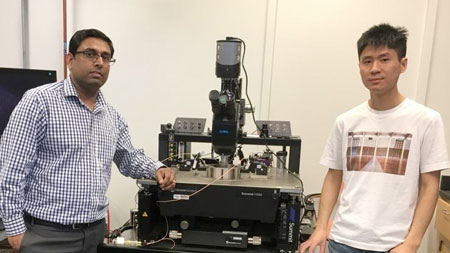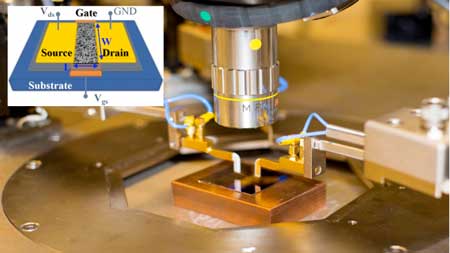| Posted: Jun 15, 2018 |
Nanotechnology research charts the way to more reliable carbon-based microelectronics
(Nanowerk News) Carbon nanotubes – cylindrical formations of carbon atoms with incredible strength and electrical conductivity – hold great promise for creating new micron-scale low-power electronic devices.
|
|
But finding a way to build a reliable computing platform based on the carbon material has been a major challenge for researchers.
|
|
Now, a team of mechanical and materials engineers at Georgia Institute of Technology has devised a method for identifying performance variabilities in transistors made from carbon nanotube networks. The new approach could help researchers create more reliable devices and ultimately harness that technology for a range of applications such as wearable electronics, sensors and antennas.
|
 |
| Satish Kumar, an associate professor in the George W. Woodruff School of Mechanical Engineering, and Jialuo Chen, a graduate student at Georgia Tech. (Image: Georgia Tech)
|
|
“Using carbon nanotubes to make thin-film transistors with good performance repeatability has been challenging because of the random imperfections in the fabrication process,” said Satish Kumar, an associate professor in the George W. Woodruff School of Mechanical Engineering. “Those random imperfections cause variations in the properties of the nanotubes – differences in length, diameter and chirality. All of those things can impact how conductive a nanotube is, which leads to these performance variations.
|
|
“What we’ve done now is created a systematic way to estimate these variations that could improve reliability for carbon nanotube network based devices,” he said.
|
|
Results from the study, which was sponsored by the National Science Foundation, were published in IEEE Transactions on Nanotechnology ("Variability in Output Characteristics of Single-Walled Carbon Nanotube Thin-Film Transistors").
|
|
While earlier research has looked at how to improve production methods for carbon nanotubes in order to achieve more uniformity, Kumar’s team focused on analyzing performance variabilities in statistical way so that performance characteristics could be more estimable.
|
|
“Such analysis is crucial to explore the reliability and stability of carbon nanotube network based circuits and to devise techniques which can help reduce variability in circuit performance for various electronic applications,” Kumar wrote with in the paper with Jialuo Chen, a graduate student at Georgia Tech.
|
 |
| A close up view of thin-film transistors formed from networks of carbon nanotubes. (Image: Georgia Tech)
|
|
While some carbon nanotubes conduct electricity much in the same way that a semiconductor such as silicon, certain carbon nanotubes have conductivity properties more similar to metal. The latter types are called metallic carbon nanotubes. The prevalence of such metallic carbon nanotubes in a network is linked to performance problems.
|
|
The study found that the metallic-property carbon nanotubes caused performance variations more so in thin-film transistors with short channels than those with long channels, which means device designers could achieve higher performance by using networks that have a higher concentration of long channel thin-film transistors.
|
|
The researchers also found that variations in length of the carbon nanotubes seemed to have less impact on performance as long as the network of nanotubes was dense.
|
|
“Our results show that the performance variability of thin-film transistors can be reconstructed using the distribution function of relevant parameters which will help us to create more reliable circuits to enable the next generation of low-cost flexible microelectronics,” Kumar said.
|


